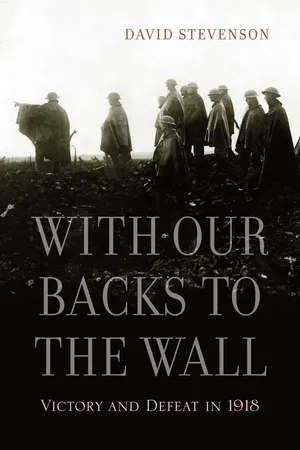History
Ludendorff Offensive
The Ludendorff Offensive was a series of German attacks on the Western Front during World War I, launched in March 1918. The offensive was named after General Erich Ludendorff, who planned and executed the attacks. Despite initial success, the offensive ultimately failed and marked the beginning of the end for Germany in the war.
Written by Perlego with AI-assistance
Related key terms
1 of 5
11 Key excerpts on "Ludendorff Offensive"
- Gerald Feldman(Author)
- 2014(Publication Date)
- Bloomsbury Academic(Publisher)
This last failing was the direct result of his incapacity to accept anything less than total victory. The great offensives of the spring of 1918 were undertaken in defiance of the opposition of some of the army's leading strategists and in complete disregard of the War Office's warning that Germany's supply of reserves would be exhausted by the spring of 1918. The ultimate effect of these offensives was to extend the German lines and drastically reduce the number of men available to hold those lines. Ludendorff*s claim that the offensives were wearing the enemy down was ridiculous. Between March and July 1918 the Statement by Dr. August Miiller, April 22, 1918, AGSOD 9 III, p. 1306. 5 2 Ludendorff to the OHL's representative to the Chancellor, Colonel von Winterfeldt, June 19, 1918, BA, Nachlass Bauer, Nr. 17. 493 T H E C O N C L U D I N G M O N T H S O F T H E W A R strength of the field army dropped from 5.1 million to 4.2 mil-lion men, while the Allied forces were supplemented by over 2 million fresh American troops. Ludendorff complained that he could have succeeded if he only had 200,000 more men. Even if this were true, however, it was impossible to justify the offensives by arguing that the men should have been there. 53 Similarly, Germany was no match for her enemies in ma-teriel. Germany's long-term productive capacity was simply inferior to those of her enemies in every respect and the Allies' increasingly massive employment of tanks and the OHL's failure to properly encourage the use and production of this weapon doomed the German cause. Ludendorff had never understood that his army's ability to hold back its numerically superior opponents depended almost entirely upon the efficacy of the machine gun. It was this—not the heavy artillery, which after a point simply further devastated what had been de-stroyed already—which gave a modicum of truth to Luden-dorff's claim that machines could be substituted for men.- eBook - PDF
With Our Backs to the Wall
Victory and Defeat in 1918
- David Stevenson(Author)
- 2011(Publication Date)
- Belknap Press(Publisher)
The months before rather than after July 1918 determined the war’s outcome. 1 The Allies’ success 31 On the Defensive, March–July 1918 on the defensive was the precondition for their success on the offensive, and would enable them to end the fighting on their terms. Germany’s assault in the west was therefore crucial. On other fronts the Central Powers were already on the offensive, but achieved more and at lower cost. In addition to the unrestricted submarine campaign, they had captured Riga and broken through at Caporetto. Yet Ger-many’s previous bids for victory in the west – on the Marne and at Verdun – had been frustrated. Ludendorff acknowledged the intract-ability of the task and that despite the Allies’ superior resources they had also failed in it. Although he had long envisaged a culminating Western Front offensive, as of September 1917 he still envisaged staying on the defensive in the spring, but in the following weeks he changed his mind and planning began. 2 Preparations German strategy for 1918 emerged from consultations between the OHL and the headquarters of the army groups and armies on the West-ern Front. Germany’s allies had little involvement in the process; as too Wilhelm II and Chancellor Georg Hertling, although they approved the end-product. Yet Crown Prince Rupprecht of Bavaria, commanding the northern army group, and Crown Prince Wilhelm of Prussia, command-ing the central one, were both unconvinced about an offensive, and their staff officers shared their scepticism. Ludendorff himself was the primary driver of the ‘Michael’ operation, and few others shared his viewpoint. He also provided the impetus in the central OHL relationship. Paul von Beneckendorff und von Hindenburg had been born in 1847 as the son of an army lieutenant. Raised on a modest estate near Posen (now Poznán) in West Prussia, he went to cadet school at eleven and served with distinction in the Austro-Prussian and Franco-Prussian wars. - eBook - ePub
Germany at War
400 Years of Military History [4 volumes]
- David T. Zabecki(Author)
- 2014(Publication Date)
- ABC-CLIO(Publisher)
The Germans, for some reason, never seemed to grasp the significance of these two critical logistics nodes. During Operation MICHAEL, the Germans came within 10 miles of Amiens; during Operation GEORGETTE, they got within 6 miles of Hazebrouck. On the tactical level of war, the Ludendorff Offensives are significant in military history because they saw the first major application by the Germans on the Western Front of what became known as "storm troop tactics"—or more correectly, infiltration tactics. The artillery tactics were new, too, with the fire planning for all five attacks being done by Colonel Georg Bruchmüller, brought in from the Eastern Front for just that purpose.David T. ZabeckiSee also: Bruchmüller, Georg; Chemin des Dames Offensive (Operation BLÜCHER); Falkenhayn, Erich von; Hindenburg, Paul von; Hoffmann, Max; Kuhl, Hermann von; Lossberg, Fritz von; Ludendorff, Erich; Lys Offensive (Operation GEORGETTE); Marne, Second Battle of the (Operation MARNESCHUTZ-REIMS); Noyon Offensive (Operation GNEISENAU); Oberste Heeresleitung (OHL); Operation HAGEN; Riga, Battle of; Rupprecht, Crown Prince of Bavaria; Saint-Quentin Offensive (Operation MICHAEL); Vernichtungsschlacht (Battle of Annihilation); Wetzell, Georg; Wilhelm, Crown Prince of PrussiaAdditional Reading
Bose, Thilo von. Deutsche Siege 1918. Bd 32. Schlachten des Weltkrieges , im Auftrage des Reichsarchivs. Berlin: Verlag Gerhard Staling, 1929.Bose, Thilo von. Wachsende Schwierigkeiten. Bd 33. Schlachten des Weltkrieges , im Auftrage des Reichsarchivs. Berlin: Verlag Gerhard Staling, 1930.Middlebrook, Martin. The Kaiser's Battle, 21 March 1918: The First Day of the German Spring Offensive . London: Penguin, 1978.Paschall, Rod. The Defeat of Imperial Germany , 1917-1918. Chapel Hill, NC: Algonquin, 1989.Pitt, Barrie. 1918: The Last Act . New York: Ballantine, 1963.Stenger, Alfred. Der Letzte deutsche Angriff: Reims 1918. Bd 34. Schlachten des Weltkrieges , im Auftrage des Reichsarchivs. Berlin: Verlag Gerhard Staling, 1930.Wynne, Graeme. If Germany Attacks: The Battle in Depth in the West - eBook - PDF
Fighting the Great War
A Global History
- Michael S. Neiberg, Michael S. NEIBERG(Authors)
- 2009(Publication Date)
- Harvard University Press(Publisher)
It appeared to many British soldiers that the Germans had the power to inflict great damage, but not enough power to force a decision. The British, for their part, could hold on, but could not deliver a knockout blow of their own. “I sup-pose,” one officer told Campbell, “it will be another Hundred Years War.” 29 The human costs of Ludendorff’s first two attacks were appall-ing. The German army had suffered 257,176 casualties in April on top of the 235,544 they had suffered in March. Germany was sim-321 . the Ludendorff Offensives . This aerial photo shows Queant, a Hindenburg Line strongpoint. Note the three belts of interlocking barbed wire (foreground, left to right) designed to protect German forces in the town itself. (Courtesy of Andrew and Herbert William Rolfe) [To view this image, refer to the print version of this title.] ply unable to replace manpower losses on this scale. The German army began to experience higher desertion rates, and some units reported that they could not expect their men to obey orders in the future. Sixth Army headquarters bluntly warned Ludendorff that “the men will not attack.” 30 Still Ludendorff pressed on. He switched his attention south to Champagne, hoping to inflict a major defeat on the French that would impel the British to stretch their line in support. After dealing with France, Ludendorff then planned to strike the extended British again in Flanders. Ludendorff launched his third offensive, code-named Blücher, in late May. His target was the infamous Chemin des Dames sec-tor, where French forces were packed in between the ridge and the Aisne River. The French commander, Denis Auguste Duchêne, had commanded a corps in this sector during the failed French at-tempts to capture the ridge in April 1917. Now, as Sixth Army commander, Pétain had urged him to establish a defense in depth. Duchêne had resisted, arguing that the terrain in the Chemin des Dames sector did not allow for such a defense. - eBook - ePub
Letters from Verdun
Frontline Experiences of an American Volunteer in World War I France
- William C. Harvey, Eric T. Harvey, William C. Harvey, Eric T. Harvey(Authors)
- 2020(Publication Date)
- Casemate(Publisher)
Part 5 Late Spring and Summer of 1918 The Ludendorff OffensivePassage contains an image Introduction
In the spring and early summer of 1918 the German high command decided to launch one last, desperate offensive to end the war on favorable terms. Eric Ludendorff gathered the pick of his combat troops for a series of lightning-fast strikes at Allied lines in the center of the Western Front. These produced immediate and dramatic gains in territory and in captured prisoners.By skillful manipulation of reserves and diversion of battle units, the French and British were able to blunt the assaults, which over a period of two months simply ran out of momentum, out of supplies and out of fresh manpower. The Allies were then quick to mount effective counterattacks that presaged the final, victorious Allied drive to the Rhine River, culminating in the general armistice of November 11th, 1918. It was during this action that Wolfe earned the Croix de Guerre.Wolfe’s account of the Battle of Bois Belleau, or Belleau Wood, the first significant victory for the Americans, and in particular the US Marines, questions the popular interpretation of this engagement.Passage contains an image Ligny-en-Barrois – May 1st
Out again and I don’t know where to this time. The division received orders to pull out on the 19th, and we left our comfortable quarters at the Barracks of Bevaux on the 20th. Down through the familiar country on the way to Bar-le-Duc, and then, to our surprise, we pull up at good old Ligny. How different it looks now in the summertime, with all the trees in leaf and flowers in profusion everywhere you look. It sure was cold when we pulled in here the last time, not five months ago. I don’t think I ever felt the cold so much as that first night that I spent sleeping in my car. But that all seems very far away now. We have good quarters in a nice clean barn in the outskirts of the town, and we are looking forward to a nice long repos - eBook - ePub
Nine Divisions in Champagne
The Second Battle of Marne
- Patrick Takle(Author)
- 2015(Publication Date)
- Pen & Sword Military(Publisher)
Bruchmüller’s targeting focused on paralyzing the defence throughout its depth by switching fire to destroy key features such as enemy headquarters, communications and artillery positions, and then culminating in a destructive firestorm on the frontline enemy trenches. The enemy’s counter-battery capability was targeted particularly by Bruchmüller’s own long-range artillery. His fire-plan emphasized the predominant use of gas shells, which incapacitated or at least reduced the efficiency of enemy troops (who were forced to wear clumsy gas masks), and did not damage the terrain in the same way as high explosives. The artillery plan then included a timetabled creeping barrage that moved just ahead of the assault troops. To maintain secrecy, most guns were concealed and were carefully registered, from the map, under central control. Ideally, the artillery fire-plan and the specialized infantry were to be brought together to a decisive area of the front in the greatest secrecy in order to achieve tactical and strategic surprise. Thus many of the assault infantry divisions and supporting artillery batteries were kept well away from the attack zone until the very last moment, in many cases only being brought forward on the very night of the attack.For all the battles of the spring offensive the Germans enjoyed an overall and local superiority in numbers of men and guns. By the spring of 1918 the Germans had massed some 191 divisions on the Western Front, to pit against ninety-nine French and sixty-three British divisions. Four brand-new American divisions (the 1st, 2nd, 26th and 42nd) had arrived in France by the end of 1917, but they were still in training and were not expected to affect events for many months. As Ludendorff presciently foresaw, ‘We must strike at the earliest moment before the Americans can throw strong forces into the scale. We must beat the British.’ For this first and greatest attack, scheduled for launch on 21 March, Ludendorff assembled seventy-six divisions (of which fifty-six were designated Stoss), - eBook - PDF
- Elizabeth Greenhalgh(Author)
- 2014(Publication Date)
- Cambridge University Press(Publisher)
7 1918: German offensives The anticipated blow fell on 21 March when Ludendorff threw down his last card in his gamble to win the war before the British could transport, and the French train and equip, enough American troops in France to trump the numerical advantage that the Germans currently possessed. Following the armistice with Russia, forty-four German divisions had transferred to the Western Front. Although these now contained fewer men than an Allied division, some of them had been specially trained in the tactics that had won decisive victories at Riga and Caporetto. At least 188 German divisions faced 163 Allied infantry divisions in France: 58 British, 99 French, and 6 American. In addition the Allies had 12 Belgian divisions, the French and British divisions in Italy and the cavalry divisions. Of the 6 US divisions, however, 2 were still disembarking and none of the others was ready to fight. The French had armed the Americans: by 15 March the total supplied amounted to 156 batteries of 75s, 35 batteries of short 155s and 5 groups of the modern extra heavies, plus 2,894 machine guns and 12,864 automatic rifles. 1 Two offensives against the British front The last intelligence before the Germans attacked reported 108 enemy divisions on the front, with 74 in reserve, whose whereabouts were known in about two-thirds of cases. The only enemy activity that the French had noted was two trench raids (coups de main) around Reims and Verdun; otherwise 20 March had been ‘a calm day overall’. 2 Pétain believed that the German offensive was about to begin, as did General Cox, the new head of intelligence at GHQ. Pétain’s head of intelligence, Colonel Cointet, agreed with Cox on the two most likely areas of attack: the rivers Scarpe and Oise, and also in Champagne. They disagreed, however, on the relative weight of the attacks, Cox judging that the French sector would see the main action, because the political situation in France was less stable. - eBook - ePub
In Their Own Words
Untold Stories of The First World War
- Anthony Richards(Author)
- 2016(Publication Date)
- Imperial War Museum(Publisher)
10 GilbertTHE GERMAN SPRING OFFENSIVE, MARCH 1918
In the thick mist, at 5am on the morning of March 21st, the storm brokeBy the beginning of 1918, the war had become an integral part of peoples’ everyday lives for those based on the home front or on active service overseas. With no immediate end in sight, it seemed as if the fighting would continue indefinitely. Yet the fifth year of the conflict would prove to be characterised by dramatic twists and turns, which led to great uncertainty over the future. Following the initial events of spring 1918, it seemed to many that the Allies may well be fighting a losing battle.Recent progress by the Allies on the Western Front had been limited, despite the perceived success of the ground-breaking use of armoured tanks during the Battle of Cambrai in November 1917. Across France and Belgium, the stalemate between the two opposing armies remained very much in place. Greater momentum had been achieved by the fighting around Passchendaele in the Third Battle of Ypres, yet the enormous cost in lives would result in the battle being regarded as a sequel to 1916’s disappointing Somme rather than a more obvious strategic victory.Among those British troops maintaining the front line defences in France was Gilbert Laithwaite, born in Dublin in July 1894 and the eldest of four children. Attending the Jesuit boarding school at Clongowes in County Kildare, he had won a scholarship to Trinity College Oxford where he distinguished himself as a classical scholar. Commissioned as a 2nd Lieutenant with the Special Reserve, Gilbert found himself attached from April 1917 to the 10th Battalion Lancashire Fusiliers, part of 52nd Brigade of the 17th Division. In March 1918 he was based with the Battalion in the Havrincourt Salient, west of the town of Cambrai. Rumours of an imminent German offensive were widespread, but neither Gilbert nor his comrades quite appreciated how near at hand such an attack was. - eBook - ePub
How the War Was Won
Command and Technology in the British Army on the Western Front: 1917-1918
- T.H.E. Travers(Author)
- 1992(Publication Date)
- Routledge(Publisher)
89The Lys offensive came to an end on 29 April, and there was then a protracted pause while the German army prepared the next assault, which eventually fell on the quiet Chemin des Dames-Aisne sector on 27 May (Map 3.4 ). This sector was held mainly by the French Sixth Army under General Duchêne, and partly on the right flank by three BEF divisions (21, 8 and 50) with one (25 Division), in reserve. Had either the BEF and the French, or the German command, gained any lessons from the March Amiens offensive or from the Lys? In several respects the Allies were at fault in not applying lessons from the past, in fact the defence was as poor as possible, given the likely German method of attack. The first problem related to surprise. Despite considerable indications of an offensive, both from GHQ and from local commanders, the French Sixth Army, in overall command of the Chemin des Dames area, refused to credit the idea, as did the BEF’s IX Corps (General Hamilton-Gordon), commanding the BEF divisions on the right wing of the sector. According to the chief of intelligence at the War Office, Macdonogh, he and Cox, in charge of intelligence at GHQ after the Lys attack, anticipated that the next German offensive would be at the Chemin des Dames in May. Moreover, the commander of 25 Division went around his positions ten days before the attack (that is, on 17 May) with his GSO 1 and recognized German artillery registration going on. This was reported first to IX Corps, who treated it as ‘an illusion’, and then to the French Sixth Army HQ, who informed the GOC of 25 Division that French Intelligence was well informed and that no attack was likely. However, around 19 May, the GSO 2 of IX Corps told the corps chief engineer that he had several air photographs showing preparations for the attack, which were also reported to Sixth Army. The latter claimed they had no evidence of an offensive, and anyway expected to have six days’ notice of an attack, although when the time came there was actually only some nine hours’ notice. Even on 26 May, the day before the assault, the CRA of 21 Division stated that while the chief intelligence officer at Sixth Army believed an offensive was probable in the near future, all the other intelligence officers at Sixth Army were unanimous that such an offensive was highly improbable, and so the 21 Division artillery officers tended to dismiss the idea of a German offensive. And according to the GOC of 8 Division, Heneker, Hamilton-Gordon at IX Corps even gave orders 24 hours before the assault to prepare as for a quiet front. Clearly the staff at IX Corps and Sixth Army had ‘painted a picture’ of the unlikelihood of a German attack in their minds.90 - Ryszard Kaczmarek(Author)
- 2020(Publication Date)
VII. 1918: Failed Spring Offensive and Retreat Last German Offensive The 1918 change of situation on the Eastern Front after the armistice and after the later Treaty of Brest-Litovsk allowed the Germans to concentrate the entirety of forces for the planned deciding spring offensive� In this way all regiments with Polish soldiers once again moved to Flanders – just like in 1914–1915 – both those temporarily placed in the Eastern Front and those permanently stationed on the Western Front� What preceded the preparations for the offensive was winter-time rest in 1918, in the hinterland of Flanders� The 22 nd Infantry Division received as much as four weeks of rest at the front’s supply base in the concentrated barrack “cities” located near the front� As usually, the soldiers were deloused before commen- cing leisure: visits to “soldier’s houses” (soldier’s canteen), movie theaters, and theaters� A new form of rest were company feasts (Kompagniefeste)� In the face increasingly acute food shortages – even on the front – a pig allotted on this day to the “feasting” company was a desirable prize� The soldiers slaughtered and boiled the pig� The main attraction always was a black pudding called krupniok; which is how every regiment from the Upper Silesia called this delicacy, regard- less of nationality� 773 What proved to cause some disturbance during this relatively careless period was the continuation of mandatory political courses for soldiers� Since educa- tional officers were not connected to particular regiments and were not known to soldiers, the lectures – in this case by professor Gehrcke from the University of Breslau, conscripted as a Landwehr officer (this name probably refers to a prominent classical philologist Alfred Gercke) – were at best ridiculed as yet another unwelcome pretext to interrupt leisure� Soldiers pretended to listen only when their commanders- eBook - PDF
Pandora’s Box
A History of the First World War
- Jörn Leonhard, Patrick Camiller(Authors)
- 2018(Publication Date)
- Belknap Press(Publisher)
This idea of wearing down the enemy on as many fronts as possible ultimately proved success-ful.68 Allied breakouts from Amiens on the Somme began simultaneously with the battle on the Marne, a characteristic example of modern warfare in P i c a r d y F l a n d e r s L o r r a i n e C h a m p a g n e Meuse Sambre Oise Aisne Semoy Marne Moselle M Meuse Marne Schelde Lys Yser A r d e n n e s A r g o n n e s Ghent Nieuport Diksmuide Ypres Lille Armentières Tournai Antwerp Brussels Louvain Maastricht Aachen Liège Charleroi Mons Namur Spa Malmedy Dinant Luxembourg Dunkirk Amiens St. Omer Ostend Étain Briey Metz Longwy Lunéville Épinal Nancy St. Mihiel Troyes Verdun Toul Paris Reims Laon Juvigny La Fère Montdidier Soissons Compiègne Montmirail Épernay Châlons-sur-Marne St. Quentin Cambrai Havrincourt Maubeuge Douai Loos Bruges Lens Arras Le Cateau-Cambrésis Sedan Mézières Château-Thierry B E L G I U M N E T H E R L A N D S F R A N C E L U X E M B O U R G N o r t h S e a 0 10 20 50km 30 40 G E R M A N R E I C H German gains, Mar.–July 1918 Michael offensive, Sept. 12–15, 1918 Ceasefire line, Nov. 11, 1918 Main thrust of Allied attacks, Sept. 26–Nov. 11, 1918 Map 11. Allied Counteroffensives on the Western Front, 1918 758 | Onrush and Collapse its tactics and use of technology. The aim of the Allied counteractions was to regain territory that German troops had overrun in the spring Michael offensive; the concentrated attack by fifteen infantry divisions, three cavalry divisions, 1,400 artillery pieces, 1,800 British and French aircraft, and 500 tanks that could be easily deployed on the relatively flat and dry terrain was certainly a success. Troops from the Dominions and the United States played a major role, with one American, four Canadian, and five Australian divisions deployed alongside five British ones. The combination of forces, backed up with rolling barrages and surprise attacks, was starting to bear fruit.
Index pages curate the most relevant extracts from our library of academic textbooks. They’ve been created using an in-house natural language model (NLM), each adding context and meaning to key research topics.










